A Literature Review: Antibiotic Efficacy for Otitis Media in Children
VerifiedAdded on 2023/06/10
|17
|4148
|110
Report
AI Summary
This report presents a literature review focused on the efficacy of two antibiotics, amoxicillin and cefuroxime, in treating otitis media (middle ear infection) in children. The rationale for this investigation stems from the prevalence of otitis media, particularly in young children, and the emergence of antibiotic resistance. The report begins with a PICO question, framing the research focus on comparing cefuroxime and amoxicillin in reducing otitis media symptoms. The methodology involves a systematic literature review, detailing the search strategy, databases used (Google Scholar, CINAHL, Medline, and university library databases), keywords, inclusion and exclusion criteria, and the PRISMA flow diagram. The findings, recommendations, and limitations of the study are discussed, including the challenge of sample size and generalizability. The report aims to provide valuable insights for healthcare professionals and researchers on the effectiveness of the antibiotics in treating otitis media and improving the quality of life for children affected by the condition.
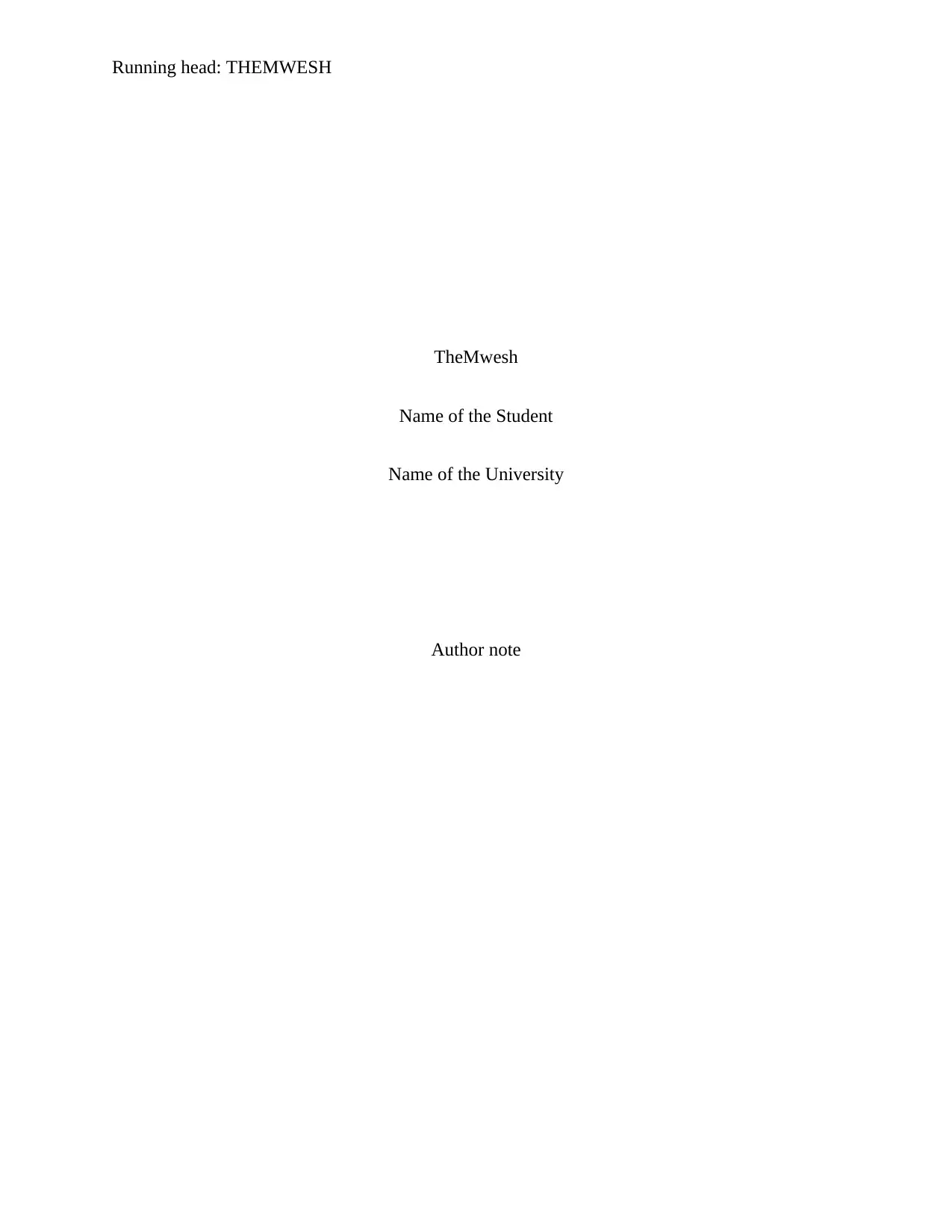
Running head: THEMWESH
TheMwesh
Name of the Student
Name of the University
Author note
TheMwesh
Name of the Student
Name of the University
Author note
Paraphrase This Document
Need a fresh take? Get an instant paraphrase of this document with our AI Paraphraser

1THEMWESH
Table of Contents
1. Rationale...................................................................................................................................2
2. Research question.....................................................................................................................4
3. Search Strategy.........................................................................................................................5
Research design...........................................................................................................................5
Search strategy and bibliographic aids........................................................................................6
Data collection and analysis........................................................................................................6
Keywords.....................................................................................................................................7
Inclusion and exclusion criteria...................................................................................................7
Search outcomes..........................................................................................................................8
PRISMA flow diagram..............................................................................................................10
Limitations of the study.............................................................................................................11
4. Main findings.........................................................................................................................11
5. Recommendations..................................................................................................................14
Table of Contents
1. Rationale...................................................................................................................................2
2. Research question.....................................................................................................................4
3. Search Strategy.........................................................................................................................5
Research design...........................................................................................................................5
Search strategy and bibliographic aids........................................................................................6
Data collection and analysis........................................................................................................6
Keywords.....................................................................................................................................7
Inclusion and exclusion criteria...................................................................................................7
Search outcomes..........................................................................................................................8
PRISMA flow diagram..............................................................................................................10
Limitations of the study.............................................................................................................11
4. Main findings.........................................................................................................................11
5. Recommendations..................................................................................................................14
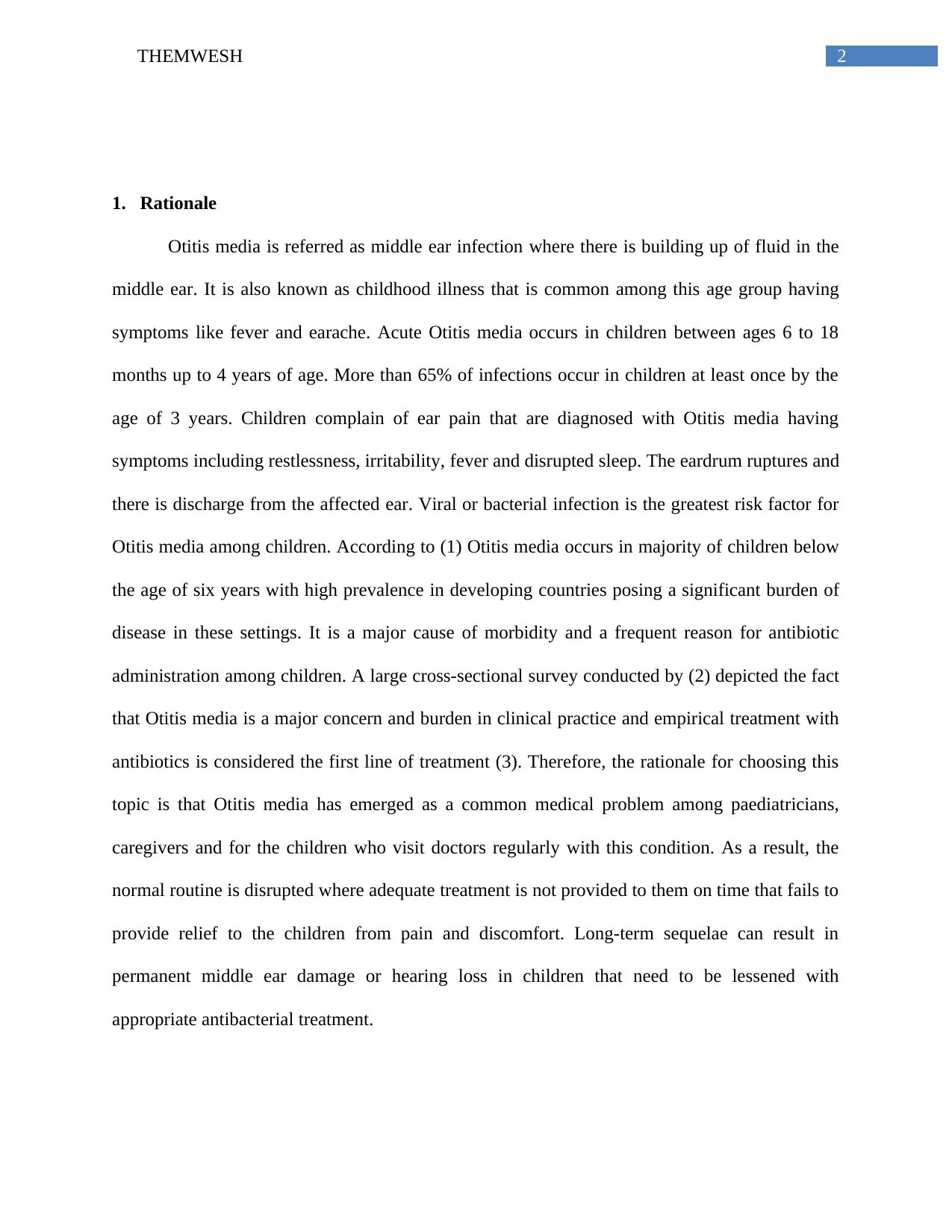
2THEMWESH
1. Rationale
Otitis media is referred as middle ear infection where there is building up of fluid in the
middle ear. It is also known as childhood illness that is common among this age group having
symptoms like fever and earache. Acute Otitis media occurs in children between ages 6 to 18
months up to 4 years of age. More than 65% of infections occur in children at least once by the
age of 3 years. Children complain of ear pain that are diagnosed with Otitis media having
symptoms including restlessness, irritability, fever and disrupted sleep. The eardrum ruptures and
there is discharge from the affected ear. Viral or bacterial infection is the greatest risk factor for
Otitis media among children. According to (1) Otitis media occurs in majority of children below
the age of six years with high prevalence in developing countries posing a significant burden of
disease in these settings. It is a major cause of morbidity and a frequent reason for antibiotic
administration among children. A large cross-sectional survey conducted by (2) depicted the fact
that Otitis media is a major concern and burden in clinical practice and empirical treatment with
antibiotics is considered the first line of treatment (3). Therefore, the rationale for choosing this
topic is that Otitis media has emerged as a common medical problem among paediatricians,
caregivers and for the children who visit doctors regularly with this condition. As a result, the
normal routine is disrupted where adequate treatment is not provided to them on time that fails to
provide relief to the children from pain and discomfort. Long-term sequelae can result in
permanent middle ear damage or hearing loss in children that need to be lessened with
appropriate antibacterial treatment.
1. Rationale
Otitis media is referred as middle ear infection where there is building up of fluid in the
middle ear. It is also known as childhood illness that is common among this age group having
symptoms like fever and earache. Acute Otitis media occurs in children between ages 6 to 18
months up to 4 years of age. More than 65% of infections occur in children at least once by the
age of 3 years. Children complain of ear pain that are diagnosed with Otitis media having
symptoms including restlessness, irritability, fever and disrupted sleep. The eardrum ruptures and
there is discharge from the affected ear. Viral or bacterial infection is the greatest risk factor for
Otitis media among children. According to (1) Otitis media occurs in majority of children below
the age of six years with high prevalence in developing countries posing a significant burden of
disease in these settings. It is a major cause of morbidity and a frequent reason for antibiotic
administration among children. A large cross-sectional survey conducted by (2) depicted the fact
that Otitis media is a major concern and burden in clinical practice and empirical treatment with
antibiotics is considered the first line of treatment (3). Therefore, the rationale for choosing this
topic is that Otitis media has emerged as a common medical problem among paediatricians,
caregivers and for the children who visit doctors regularly with this condition. As a result, the
normal routine is disrupted where adequate treatment is not provided to them on time that fails to
provide relief to the children from pain and discomfort. Long-term sequelae can result in
permanent middle ear damage or hearing loss in children that need to be lessened with
appropriate antibacterial treatment.
⊘ This is a preview!⊘
Do you want full access?
Subscribe today to unlock all pages.

Trusted by 1+ million students worldwide
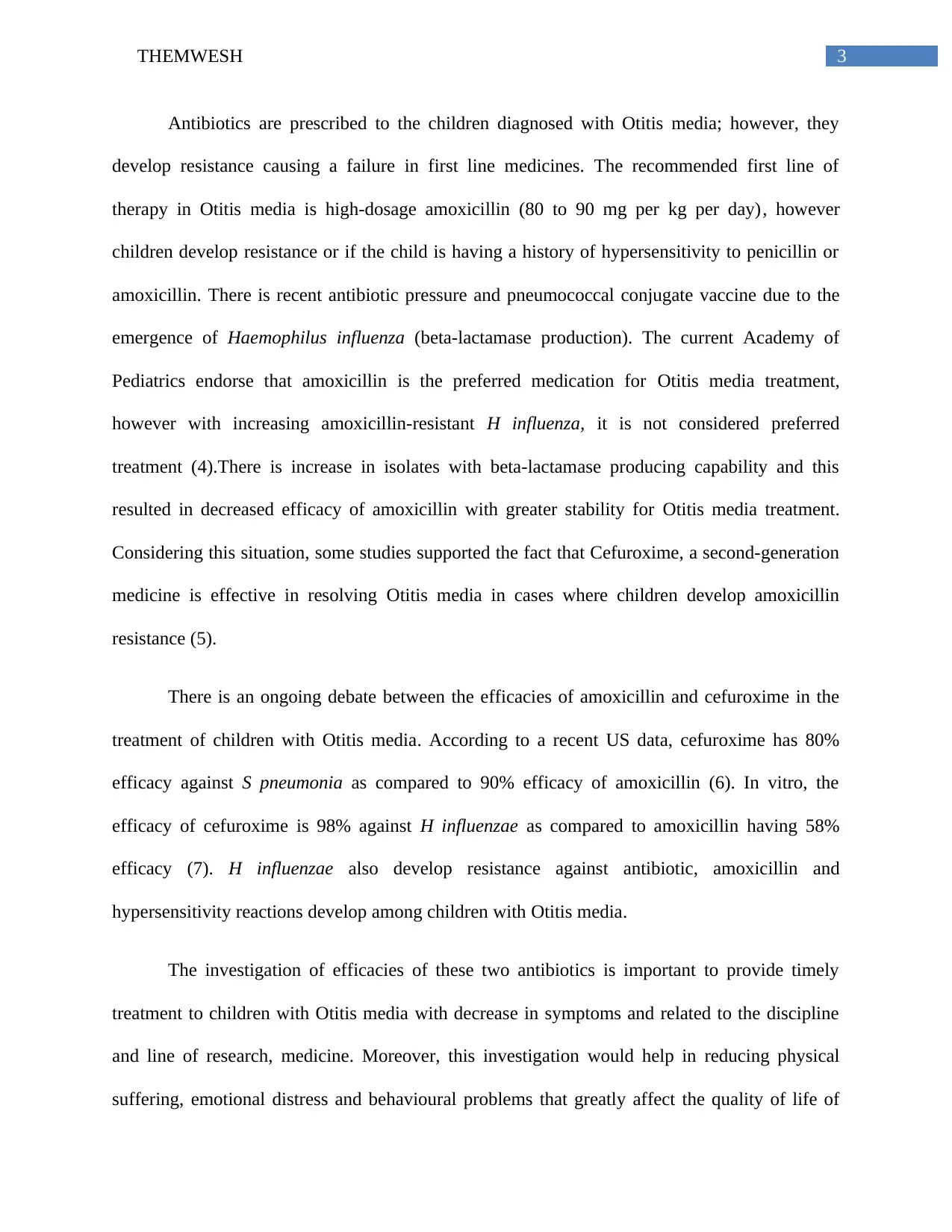
3THEMWESH
Antibiotics are prescribed to the children diagnosed with Otitis media; however, they
develop resistance causing a failure in first line medicines. The recommended first line of
therapy in Otitis media is high-dosage amoxicillin (80 to 90 mg per kg per day), however
children develop resistance or if the child is having a history of hypersensitivity to penicillin or
amoxicillin. There is recent antibiotic pressure and pneumococcal conjugate vaccine due to the
emergence of Haemophilus influenza (beta-lactamase production). The current Academy of
Pediatrics endorse that amoxicillin is the preferred medication for Otitis media treatment,
however with increasing amoxicillin-resistant H influenza, it is not considered preferred
treatment (4).There is increase in isolates with beta-lactamase producing capability and this
resulted in decreased efficacy of amoxicillin with greater stability for Otitis media treatment.
Considering this situation, some studies supported the fact that Cefuroxime, a second-generation
medicine is effective in resolving Otitis media in cases where children develop amoxicillin
resistance (5).
There is an ongoing debate between the efficacies of amoxicillin and cefuroxime in the
treatment of children with Otitis media. According to a recent US data, cefuroxime has 80%
efficacy against S pneumonia as compared to 90% efficacy of amoxicillin (6). In vitro, the
efficacy of cefuroxime is 98% against H influenzae as compared to amoxicillin having 58%
efficacy (7). H influenzae also develop resistance against antibiotic, amoxicillin and
hypersensitivity reactions develop among children with Otitis media.
The investigation of efficacies of these two antibiotics is important to provide timely
treatment to children with Otitis media with decrease in symptoms and related to the discipline
and line of research, medicine. Moreover, this investigation would help in reducing physical
suffering, emotional distress and behavioural problems that greatly affect the quality of life of
Antibiotics are prescribed to the children diagnosed with Otitis media; however, they
develop resistance causing a failure in first line medicines. The recommended first line of
therapy in Otitis media is high-dosage amoxicillin (80 to 90 mg per kg per day), however
children develop resistance or if the child is having a history of hypersensitivity to penicillin or
amoxicillin. There is recent antibiotic pressure and pneumococcal conjugate vaccine due to the
emergence of Haemophilus influenza (beta-lactamase production). The current Academy of
Pediatrics endorse that amoxicillin is the preferred medication for Otitis media treatment,
however with increasing amoxicillin-resistant H influenza, it is not considered preferred
treatment (4).There is increase in isolates with beta-lactamase producing capability and this
resulted in decreased efficacy of amoxicillin with greater stability for Otitis media treatment.
Considering this situation, some studies supported the fact that Cefuroxime, a second-generation
medicine is effective in resolving Otitis media in cases where children develop amoxicillin
resistance (5).
There is an ongoing debate between the efficacies of amoxicillin and cefuroxime in the
treatment of children with Otitis media. According to a recent US data, cefuroxime has 80%
efficacy against S pneumonia as compared to 90% efficacy of amoxicillin (6). In vitro, the
efficacy of cefuroxime is 98% against H influenzae as compared to amoxicillin having 58%
efficacy (7). H influenzae also develop resistance against antibiotic, amoxicillin and
hypersensitivity reactions develop among children with Otitis media.
The investigation of efficacies of these two antibiotics is important to provide timely
treatment to children with Otitis media with decrease in symptoms and related to the discipline
and line of research, medicine. Moreover, this investigation would help in reducing physical
suffering, emotional distress and behavioural problems that greatly affect the quality of life of
Paraphrase This Document
Need a fresh take? Get an instant paraphrase of this document with our AI Paraphraser
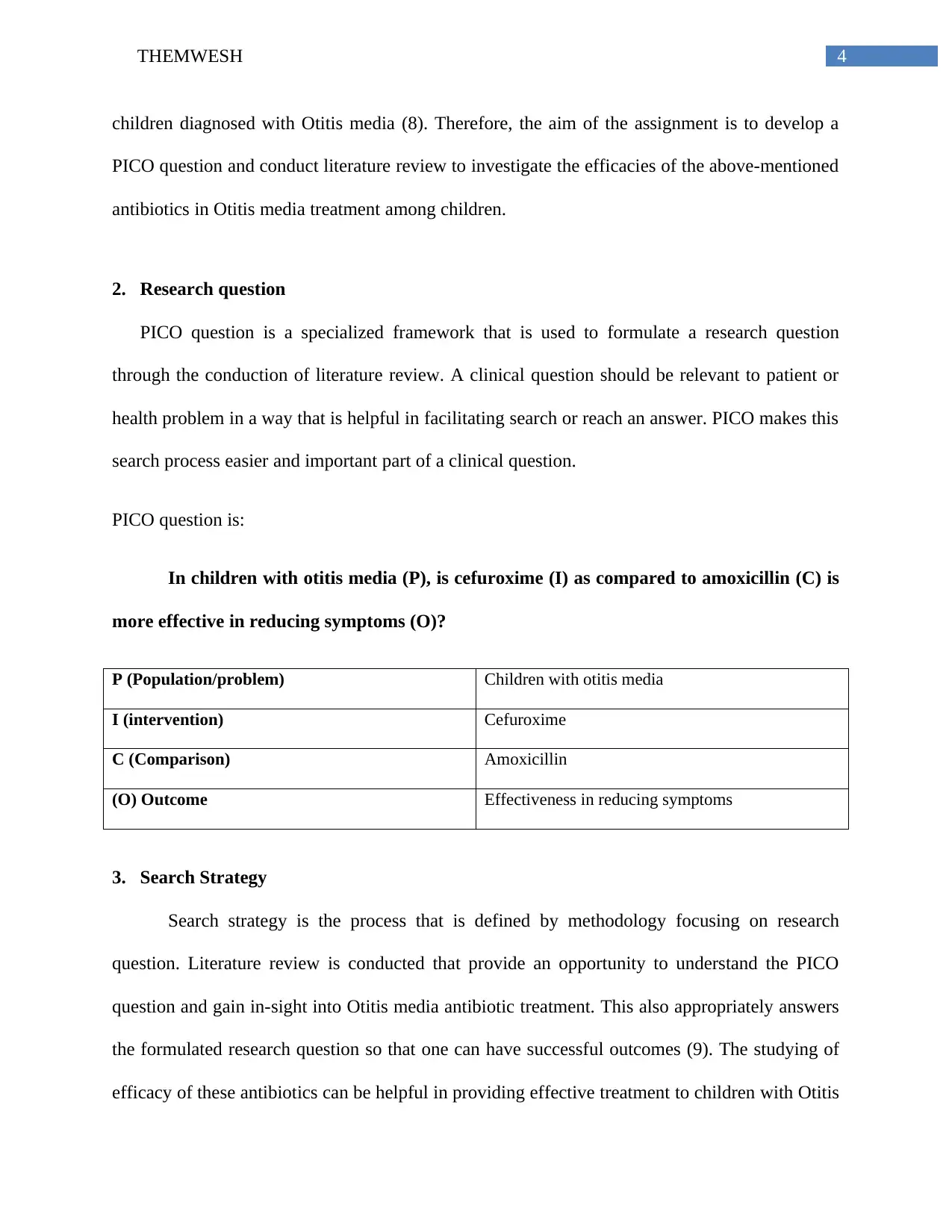
4THEMWESH
children diagnosed with Otitis media (8). Therefore, the aim of the assignment is to develop a
PICO question and conduct literature review to investigate the efficacies of the above-mentioned
antibiotics in Otitis media treatment among children.
2. Research question
PICO question is a specialized framework that is used to formulate a research question
through the conduction of literature review. A clinical question should be relevant to patient or
health problem in a way that is helpful in facilitating search or reach an answer. PICO makes this
search process easier and important part of a clinical question.
PICO question is:
In children with otitis media (P), is cefuroxime (I) as compared to amoxicillin (C) is
more effective in reducing symptoms (O)?
P (Population/problem) Children with otitis media
I (intervention) Cefuroxime
C (Comparison) Amoxicillin
(O) Outcome Effectiveness in reducing symptoms
3. Search Strategy
Search strategy is the process that is defined by methodology focusing on research
question. Literature review is conducted that provide an opportunity to understand the PICO
question and gain in-sight into Otitis media antibiotic treatment. This also appropriately answers
the formulated research question so that one can have successful outcomes (9). The studying of
efficacy of these antibiotics can be helpful in providing effective treatment to children with Otitis
children diagnosed with Otitis media (8). Therefore, the aim of the assignment is to develop a
PICO question and conduct literature review to investigate the efficacies of the above-mentioned
antibiotics in Otitis media treatment among children.
2. Research question
PICO question is a specialized framework that is used to formulate a research question
through the conduction of literature review. A clinical question should be relevant to patient or
health problem in a way that is helpful in facilitating search or reach an answer. PICO makes this
search process easier and important part of a clinical question.
PICO question is:
In children with otitis media (P), is cefuroxime (I) as compared to amoxicillin (C) is
more effective in reducing symptoms (O)?
P (Population/problem) Children with otitis media
I (intervention) Cefuroxime
C (Comparison) Amoxicillin
(O) Outcome Effectiveness in reducing symptoms
3. Search Strategy
Search strategy is the process that is defined by methodology focusing on research
question. Literature review is conducted that provide an opportunity to understand the PICO
question and gain in-sight into Otitis media antibiotic treatment. This also appropriately answers
the formulated research question so that one can have successful outcomes (9). The studying of
efficacy of these antibiotics can be helpful in providing effective treatment to children with Otitis

5THEMWESH
media. An exploration of pool of vast literature is linked to research topic where qualitative
approach in systematic literature review is conducted that helps in enhancing the mechanism of
action of these drugs so that appropriate treatment can be given to children diagnosed with OM.
This section will illustrate the steps involved in systematic literature review to find relevant
articles. The keywords, databases, bibliographic aids, research approach and design, inclusion
and exclusion criteria, data collection and outcomes are explained in this section.
Research design
Research design refers to the framework adopted for the data collection and use of
appropriate methodology (10). In this systematic review, qualitative approach will be used that
focuses on understanding the efficacy of drugs, Cefuroxime and amoxicillin in reducing
symptoms of Otitis media in children. Peer-reviewed journals will be explored and reviewed that
can be beneficial in fulfilling the research question (PICO). Relevant data will be collected about
antibiotic treatment on Otitis media in children to obtain an insight into the mentioned drugs
efficacies in reducing symptoms fulfilling the PICO question. In this research design, the
published articles will be evaluated against pre-determined criteria
Search strategy and bibliographic aids
Secondary research and systematic review will be conducted for the current research that
explores the literature available on antibiotic treatment in Otitis media among children. Otitis
media is a significant burden for the practitioners as amoxicillin administration gradually
develops resistance that is not preferred as a first line of treatment. Cefuroxime is the second-
generation treatment that is showing better efficacy to resistance. Therefore, this assignment will
derive themes from the collected data and use them to draw conclusions and give
media. An exploration of pool of vast literature is linked to research topic where qualitative
approach in systematic literature review is conducted that helps in enhancing the mechanism of
action of these drugs so that appropriate treatment can be given to children diagnosed with OM.
This section will illustrate the steps involved in systematic literature review to find relevant
articles. The keywords, databases, bibliographic aids, research approach and design, inclusion
and exclusion criteria, data collection and outcomes are explained in this section.
Research design
Research design refers to the framework adopted for the data collection and use of
appropriate methodology (10). In this systematic review, qualitative approach will be used that
focuses on understanding the efficacy of drugs, Cefuroxime and amoxicillin in reducing
symptoms of Otitis media in children. Peer-reviewed journals will be explored and reviewed that
can be beneficial in fulfilling the research question (PICO). Relevant data will be collected about
antibiotic treatment on Otitis media in children to obtain an insight into the mentioned drugs
efficacies in reducing symptoms fulfilling the PICO question. In this research design, the
published articles will be evaluated against pre-determined criteria
Search strategy and bibliographic aids
Secondary research and systematic review will be conducted for the current research that
explores the literature available on antibiotic treatment in Otitis media among children. Otitis
media is a significant burden for the practitioners as amoxicillin administration gradually
develops resistance that is not preferred as a first line of treatment. Cefuroxime is the second-
generation treatment that is showing better efficacy to resistance. Therefore, this assignment will
derive themes from the collected data and use them to draw conclusions and give
⊘ This is a preview!⊘
Do you want full access?
Subscribe today to unlock all pages.

Trusted by 1+ million students worldwide
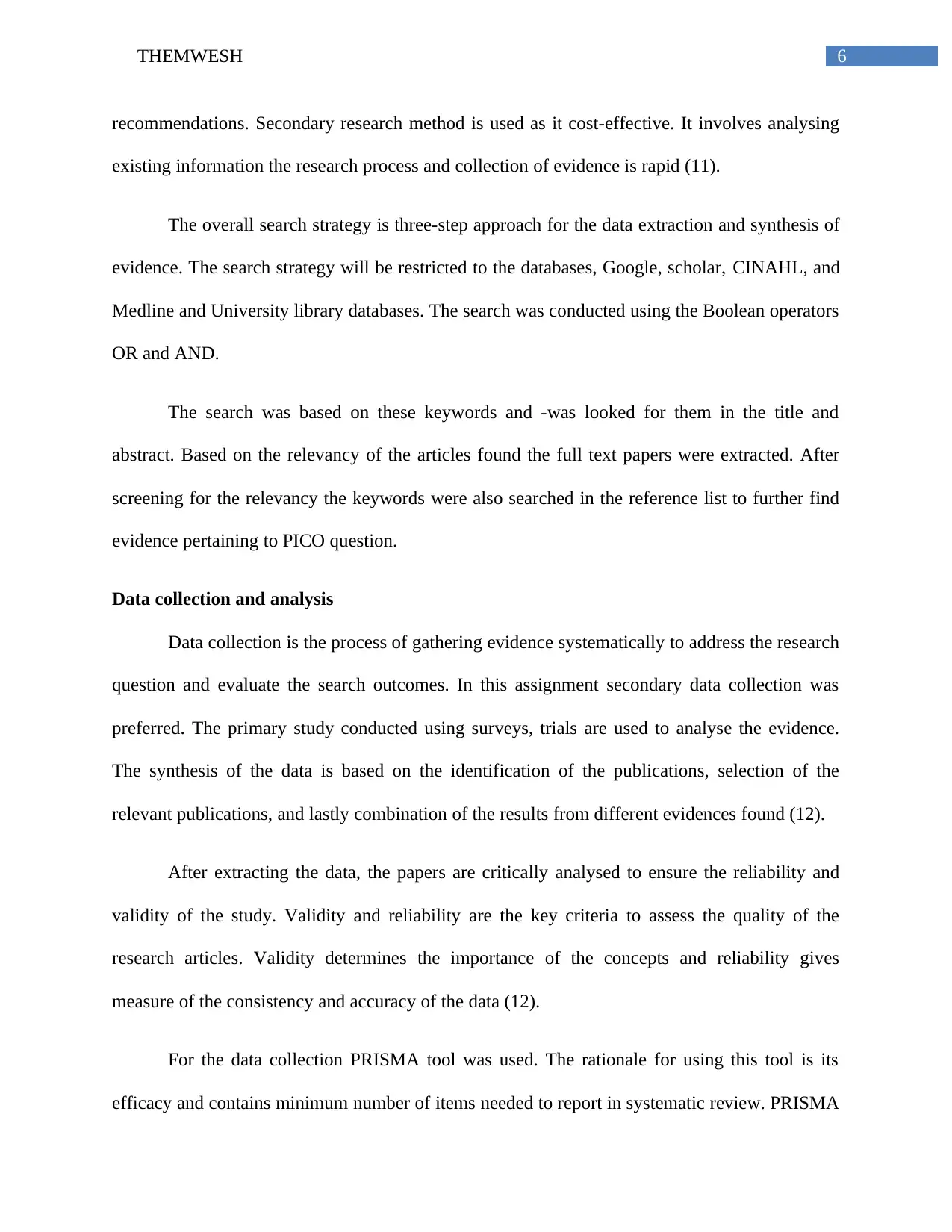
6THEMWESH
recommendations. Secondary research method is used as it cost-effective. It involves analysing
existing information the research process and collection of evidence is rapid (11).
The overall search strategy is three-step approach for the data extraction and synthesis of
evidence. The search strategy will be restricted to the databases, Google, scholar, CINAHL, and
Medline and University library databases. The search was conducted using the Boolean operators
OR and AND.
The search was based on these keywords and -was looked for them in the title and
abstract. Based on the relevancy of the articles found the full text papers were extracted. After
screening for the relevancy the keywords were also searched in the reference list to further find
evidence pertaining to PICO question.
Data collection and analysis
Data collection is the process of gathering evidence systematically to address the research
question and evaluate the search outcomes. In this assignment secondary data collection was
preferred. The primary study conducted using surveys, trials are used to analyse the evidence.
The synthesis of the data is based on the identification of the publications, selection of the
relevant publications, and lastly combination of the results from different evidences found (12).
After extracting the data, the papers are critically analysed to ensure the reliability and
validity of the study. Validity and reliability are the key criteria to assess the quality of the
research articles. Validity determines the importance of the concepts and reliability gives
measure of the consistency and accuracy of the data (12).
For the data collection PRISMA tool was used. The rationale for using this tool is its
efficacy and contains minimum number of items needed to report in systematic review. PRISMA
recommendations. Secondary research method is used as it cost-effective. It involves analysing
existing information the research process and collection of evidence is rapid (11).
The overall search strategy is three-step approach for the data extraction and synthesis of
evidence. The search strategy will be restricted to the databases, Google, scholar, CINAHL, and
Medline and University library databases. The search was conducted using the Boolean operators
OR and AND.
The search was based on these keywords and -was looked for them in the title and
abstract. Based on the relevancy of the articles found the full text papers were extracted. After
screening for the relevancy the keywords were also searched in the reference list to further find
evidence pertaining to PICO question.
Data collection and analysis
Data collection is the process of gathering evidence systematically to address the research
question and evaluate the search outcomes. In this assignment secondary data collection was
preferred. The primary study conducted using surveys, trials are used to analyse the evidence.
The synthesis of the data is based on the identification of the publications, selection of the
relevant publications, and lastly combination of the results from different evidences found (12).
After extracting the data, the papers are critically analysed to ensure the reliability and
validity of the study. Validity and reliability are the key criteria to assess the quality of the
research articles. Validity determines the importance of the concepts and reliability gives
measure of the consistency and accuracy of the data (12).
For the data collection PRISMA tool was used. The rationale for using this tool is its
efficacy and contains minimum number of items needed to report in systematic review. PRISMA
Paraphrase This Document
Need a fresh take? Get an instant paraphrase of this document with our AI Paraphraser

7THEMWESH
is beneficial in determining the benefits and harms of the health care intervention. It is useful
tool for maintaining transparency in reporting the systematic review (9).
Keywords
Appropriate keywords are required before commencing with the database search. These
words must be related to the research question, covering the key aspects. It will help identify the
relevant articles. The keywords used for the search are otitis media, children, cefuroxime,
amoxicillin, efficacy, reduced symptoms, hypersensitive to amoxicillin, and effectiveness.
Inclusion and exclusion criteria
Inclusion and exclusion criteria are required to narrow down the search so that relevant
articles are extracted that can address the PICO question. Searching the databases using the
keywords such as “otitis media in children” will yield broad results. Use of inclusion and
exclusion criteria will help restrict the articles to PICO question and its aspects. It will help
eliminate irrelevant articles not pertaining to investigation (13).
The inclusion criteria for the search are the extraction of the papers published in English
language and published in the year 2005-2018. Further research conducted with children was
taken into consideration. Only peer reviewed articles were included in the study. The evidence
will be collected from both qualitative and quantitative studies. Studies published in the
languages other than English are excluded. The search excluded expert review papers. Further,
the duplicate records, book chapters, editorials and those not addressing the PICO question are
excluded. The articles published beyond 2005 are excluded.
is beneficial in determining the benefits and harms of the health care intervention. It is useful
tool for maintaining transparency in reporting the systematic review (9).
Keywords
Appropriate keywords are required before commencing with the database search. These
words must be related to the research question, covering the key aspects. It will help identify the
relevant articles. The keywords used for the search are otitis media, children, cefuroxime,
amoxicillin, efficacy, reduced symptoms, hypersensitive to amoxicillin, and effectiveness.
Inclusion and exclusion criteria
Inclusion and exclusion criteria are required to narrow down the search so that relevant
articles are extracted that can address the PICO question. Searching the databases using the
keywords such as “otitis media in children” will yield broad results. Use of inclusion and
exclusion criteria will help restrict the articles to PICO question and its aspects. It will help
eliminate irrelevant articles not pertaining to investigation (13).
The inclusion criteria for the search are the extraction of the papers published in English
language and published in the year 2005-2018. Further research conducted with children was
taken into consideration. Only peer reviewed articles were included in the study. The evidence
will be collected from both qualitative and quantitative studies. Studies published in the
languages other than English are excluded. The search excluded expert review papers. Further,
the duplicate records, book chapters, editorials and those not addressing the PICO question are
excluded. The articles published beyond 2005 are excluded.
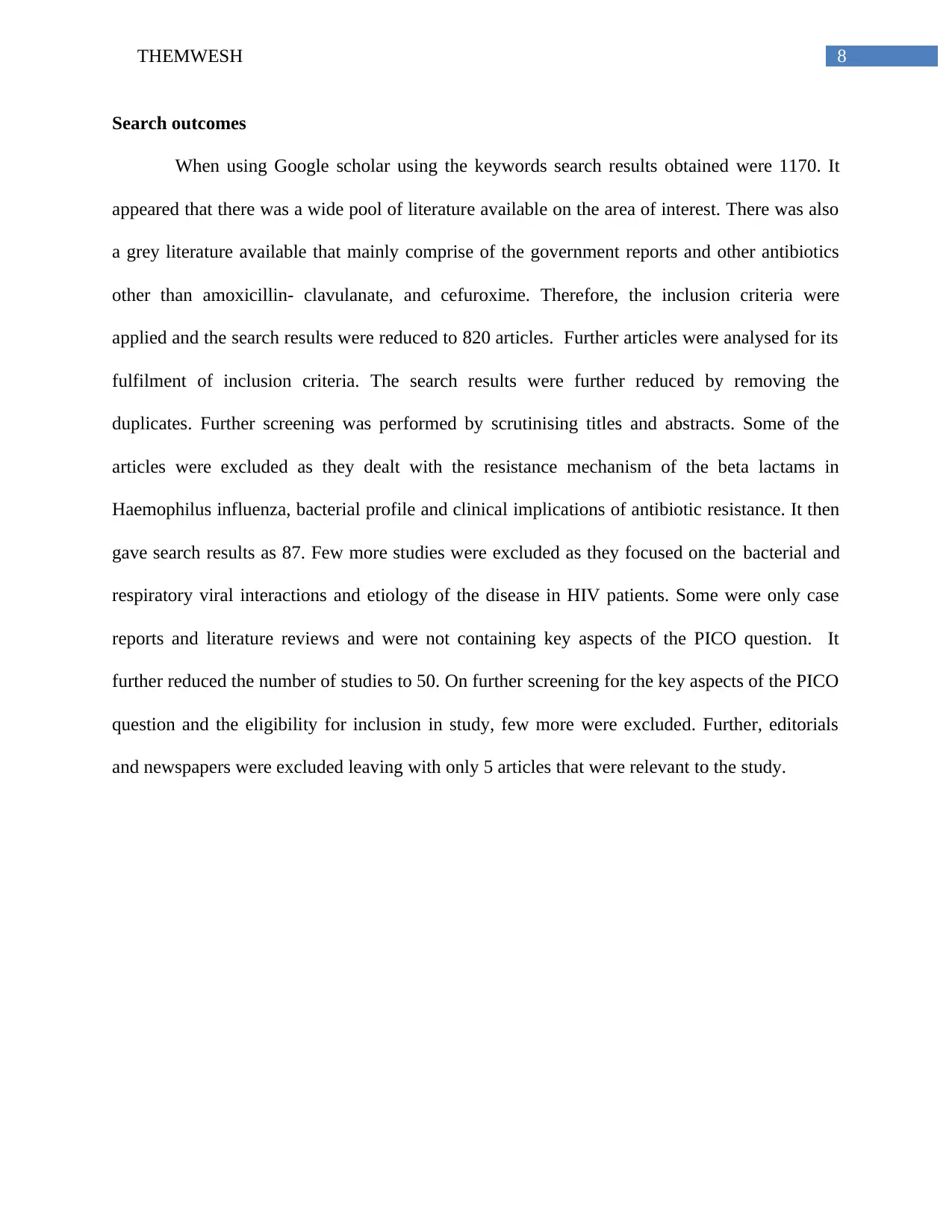
8THEMWESH
Search outcomes
When using Google scholar using the keywords search results obtained were 1170. It
appeared that there was a wide pool of literature available on the area of interest. There was also
a grey literature available that mainly comprise of the government reports and other antibiotics
other than amoxicillin- clavulanate, and cefuroxime. Therefore, the inclusion criteria were
applied and the search results were reduced to 820 articles. Further articles were analysed for its
fulfilment of inclusion criteria. The search results were further reduced by removing the
duplicates. Further screening was performed by scrutinising titles and abstracts. Some of the
articles were excluded as they dealt with the resistance mechanism of the beta lactams in
Haemophilus influenza, bacterial profile and clinical implications of antibiotic resistance. It then
gave search results as 87. Few more studies were excluded as they focused on the bacterial and
respiratory viral interactions and etiology of the disease in HIV patients. Some were only case
reports and literature reviews and were not containing key aspects of the PICO question. It
further reduced the number of studies to 50. On further screening for the key aspects of the PICO
question and the eligibility for inclusion in study, few more were excluded. Further, editorials
and newspapers were excluded leaving with only 5 articles that were relevant to the study.
Search outcomes
When using Google scholar using the keywords search results obtained were 1170. It
appeared that there was a wide pool of literature available on the area of interest. There was also
a grey literature available that mainly comprise of the government reports and other antibiotics
other than amoxicillin- clavulanate, and cefuroxime. Therefore, the inclusion criteria were
applied and the search results were reduced to 820 articles. Further articles were analysed for its
fulfilment of inclusion criteria. The search results were further reduced by removing the
duplicates. Further screening was performed by scrutinising titles and abstracts. Some of the
articles were excluded as they dealt with the resistance mechanism of the beta lactams in
Haemophilus influenza, bacterial profile and clinical implications of antibiotic resistance. It then
gave search results as 87. Few more studies were excluded as they focused on the bacterial and
respiratory viral interactions and etiology of the disease in HIV patients. Some were only case
reports and literature reviews and were not containing key aspects of the PICO question. It
further reduced the number of studies to 50. On further screening for the key aspects of the PICO
question and the eligibility for inclusion in study, few more were excluded. Further, editorials
and newspapers were excluded leaving with only 5 articles that were relevant to the study.
⊘ This is a preview!⊘
Do you want full access?
Subscribe today to unlock all pages.

Trusted by 1+ million students worldwide
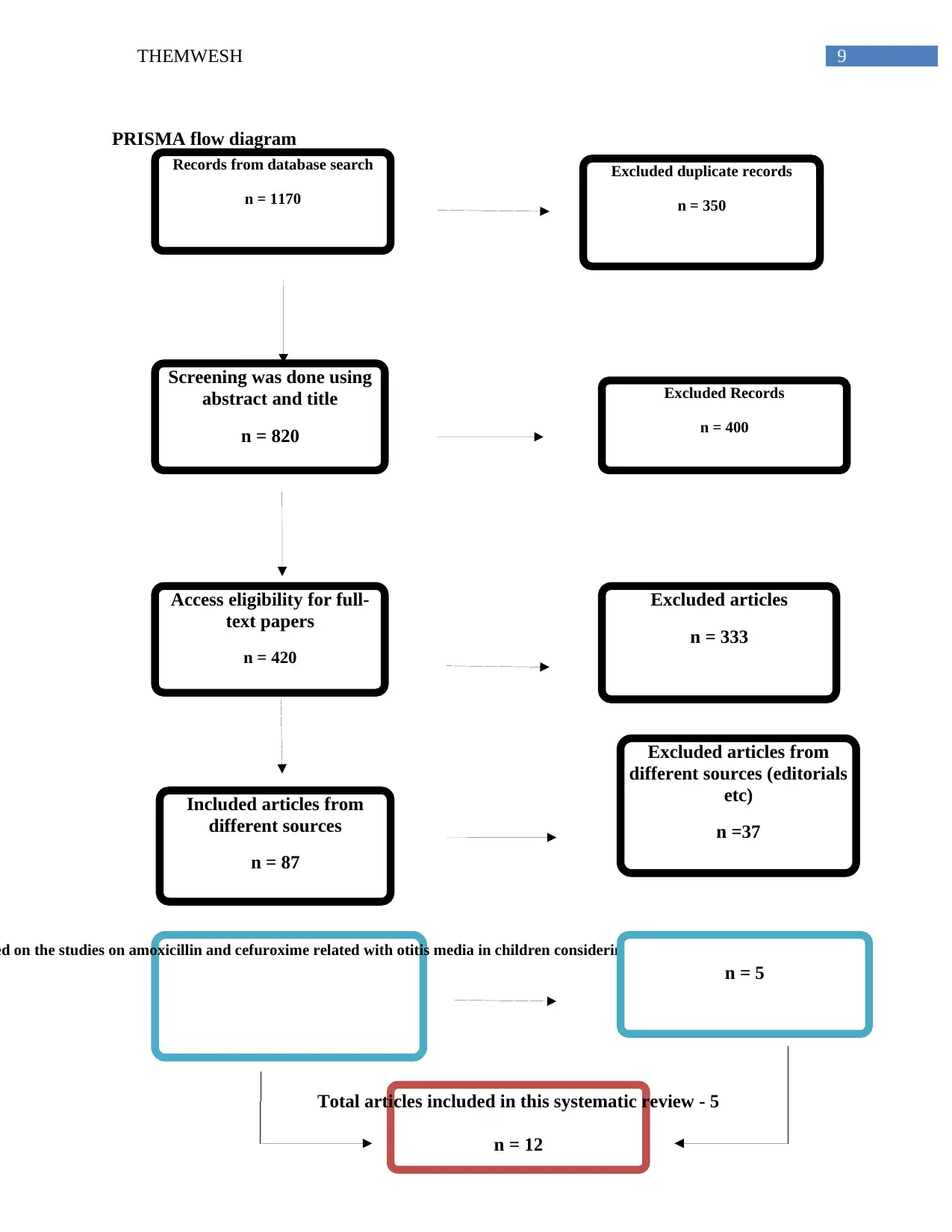
9THEMWESH
ed on the studies on amoxicillin and cefuroxime related with otitis media in children considering effectiveness
n = 5
Total articles included in this systematic review - 5
n = 12
PRISMA flow diagram
Records from database search
n = 1170
Excluded duplicate records
n = 350
Screening was done using
abstract and title
n = 820
Excluded Records
n = 400
Access eligibility for full-
text papers
n = 420
Excluded articles
n = 333
Included articles from
different sources
n = 87
Excluded articles from
different sources (editorials
etc)
n =37
ed on the studies on amoxicillin and cefuroxime related with otitis media in children considering effectiveness
n = 5
Total articles included in this systematic review - 5
n = 12
PRISMA flow diagram
Records from database search
n = 1170
Excluded duplicate records
n = 350
Screening was done using
abstract and title
n = 820
Excluded Records
n = 400
Access eligibility for full-
text papers
n = 420
Excluded articles
n = 333
Included articles from
different sources
n = 87
Excluded articles from
different sources (editorials
etc)
n =37
Paraphrase This Document
Need a fresh take? Get an instant paraphrase of this document with our AI Paraphraser

10THEMWESH
Limitations of the study
There might be several inconsistencies and limitations in regards to studies involved.
Sample size, and poor generalisability was major limitations. Another limitation is lack of
sufficient data focussing on cefuroxime and its impact on treatment of otitis media in children.
Therefore, small study bias is the key limitation. Bias in other included studies may affect the
summary as one may form any opinion as per personal interpretation from evidences (14).
4. Main findings
In the prospective epidemiological study by (15) antimicrobial susceptibility was tested
in children receiving treatment for otitis media. The microorganisms predominant in the cultures
are Streptococcus pneumoniae and Haemophilus influenza. It was found that both were
resistant to cefuroxime only 2% when compared to other antibiotics like ampicillin. The results
are indicating that cefuroxime may be effective in treating children with otitis media. However,
the results are limited as it does not consider if there are any side effects of cefuroxime. Also the
study was conducted in the public clinical setting where the sample of Chilean children
does not represent the Chilean population completely.
This result was contradicted by the findings of (16), that evaluated the antimicrobial
susceptibility of the non-typeable Haemophilus influenzae (NTHi) in otitis media. The author
evaluated the role of the agent in pediatric otitis media. A positive correlation was obtained
between NTHi and complex OM. According to author, amoxicillin/clavulanate should be the
first line therapy for otitis media. As per the study findings based on samples of ear fluids
collected of children <18 years from 2010-2015, the susceptibility of the NTHi to
Limitations of the study
There might be several inconsistencies and limitations in regards to studies involved.
Sample size, and poor generalisability was major limitations. Another limitation is lack of
sufficient data focussing on cefuroxime and its impact on treatment of otitis media in children.
Therefore, small study bias is the key limitation. Bias in other included studies may affect the
summary as one may form any opinion as per personal interpretation from evidences (14).
4. Main findings
In the prospective epidemiological study by (15) antimicrobial susceptibility was tested
in children receiving treatment for otitis media. The microorganisms predominant in the cultures
are Streptococcus pneumoniae and Haemophilus influenza. It was found that both were
resistant to cefuroxime only 2% when compared to other antibiotics like ampicillin. The results
are indicating that cefuroxime may be effective in treating children with otitis media. However,
the results are limited as it does not consider if there are any side effects of cefuroxime. Also the
study was conducted in the public clinical setting where the sample of Chilean children
does not represent the Chilean population completely.
This result was contradicted by the findings of (16), that evaluated the antimicrobial
susceptibility of the non-typeable Haemophilus influenzae (NTHi) in otitis media. The author
evaluated the role of the agent in pediatric otitis media. A positive correlation was obtained
between NTHi and complex OM. According to author, amoxicillin/clavulanate should be the
first line therapy for otitis media. As per the study findings based on samples of ear fluids
collected of children <18 years from 2010-2015, the susceptibility of the NTHi to
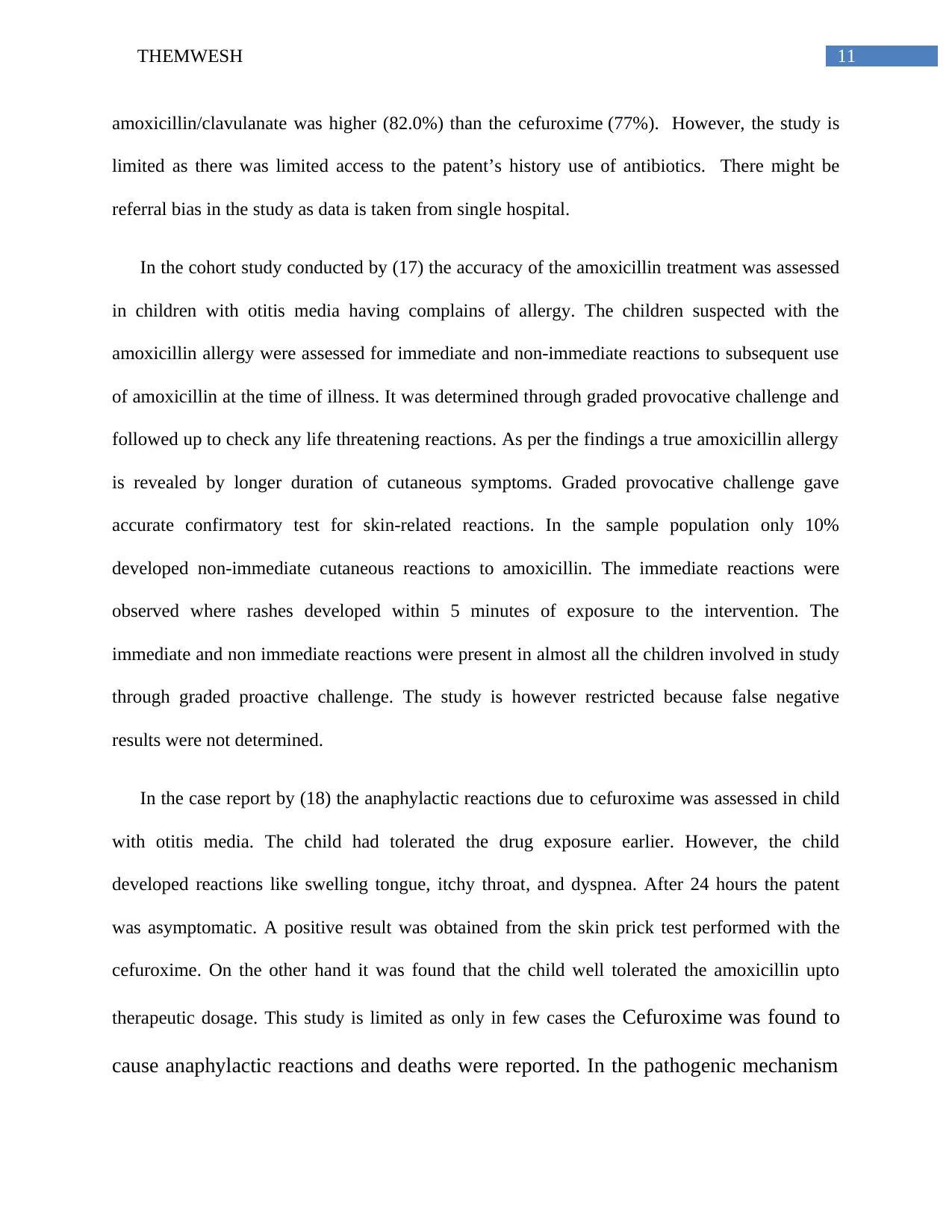
11THEMWESH
amoxicillin/clavulanate was higher (82.0%) than the cefuroxime (77%). However, the study is
limited as there was limited access to the patent’s history use of antibiotics. There might be
referral bias in the study as data is taken from single hospital.
In the cohort study conducted by (17) the accuracy of the amoxicillin treatment was assessed
in children with otitis media having complains of allergy. The children suspected with the
amoxicillin allergy were assessed for immediate and non-immediate reactions to subsequent use
of amoxicillin at the time of illness. It was determined through graded provocative challenge and
followed up to check any life threatening reactions. As per the findings a true amoxicillin allergy
is revealed by longer duration of cutaneous symptoms. Graded provocative challenge gave
accurate confirmatory test for skin-related reactions. In the sample population only 10%
developed non-immediate cutaneous reactions to amoxicillin. The immediate reactions were
observed where rashes developed within 5 minutes of exposure to the intervention. The
immediate and non immediate reactions were present in almost all the children involved in study
through graded proactive challenge. The study is however restricted because false negative
results were not determined.
In the case report by (18) the anaphylactic reactions due to cefuroxime was assessed in child
with otitis media. The child had tolerated the drug exposure earlier. However, the child
developed reactions like swelling tongue, itchy throat, and dyspnea. After 24 hours the patent
was asymptomatic. A positive result was obtained from the skin prick test performed with the
cefuroxime. On the other hand it was found that the child well tolerated the amoxicillin upto
therapeutic dosage. This study is limited as only in few cases the Cefuroxime was found to
cause anaphylactic reactions and deaths were reported. In the pathogenic mechanism
amoxicillin/clavulanate was higher (82.0%) than the cefuroxime (77%). However, the study is
limited as there was limited access to the patent’s history use of antibiotics. There might be
referral bias in the study as data is taken from single hospital.
In the cohort study conducted by (17) the accuracy of the amoxicillin treatment was assessed
in children with otitis media having complains of allergy. The children suspected with the
amoxicillin allergy were assessed for immediate and non-immediate reactions to subsequent use
of amoxicillin at the time of illness. It was determined through graded provocative challenge and
followed up to check any life threatening reactions. As per the findings a true amoxicillin allergy
is revealed by longer duration of cutaneous symptoms. Graded provocative challenge gave
accurate confirmatory test for skin-related reactions. In the sample population only 10%
developed non-immediate cutaneous reactions to amoxicillin. The immediate reactions were
observed where rashes developed within 5 minutes of exposure to the intervention. The
immediate and non immediate reactions were present in almost all the children involved in study
through graded proactive challenge. The study is however restricted because false negative
results were not determined.
In the case report by (18) the anaphylactic reactions due to cefuroxime was assessed in child
with otitis media. The child had tolerated the drug exposure earlier. However, the child
developed reactions like swelling tongue, itchy throat, and dyspnea. After 24 hours the patent
was asymptomatic. A positive result was obtained from the skin prick test performed with the
cefuroxime. On the other hand it was found that the child well tolerated the amoxicillin upto
therapeutic dosage. This study is limited as only in few cases the Cefuroxime was found to
cause anaphylactic reactions and deaths were reported. In the pathogenic mechanism
⊘ This is a preview!⊘
Do you want full access?
Subscribe today to unlock all pages.

Trusted by 1+ million students worldwide
1 out of 17
Related Documents
Your All-in-One AI-Powered Toolkit for Academic Success.
+13062052269
info@desklib.com
Available 24*7 on WhatsApp / Email
![[object Object]](/_next/static/media/star-bottom.7253800d.svg)
Unlock your academic potential
Copyright © 2020–2026 A2Z Services. All Rights Reserved. Developed and managed by ZUCOL.





